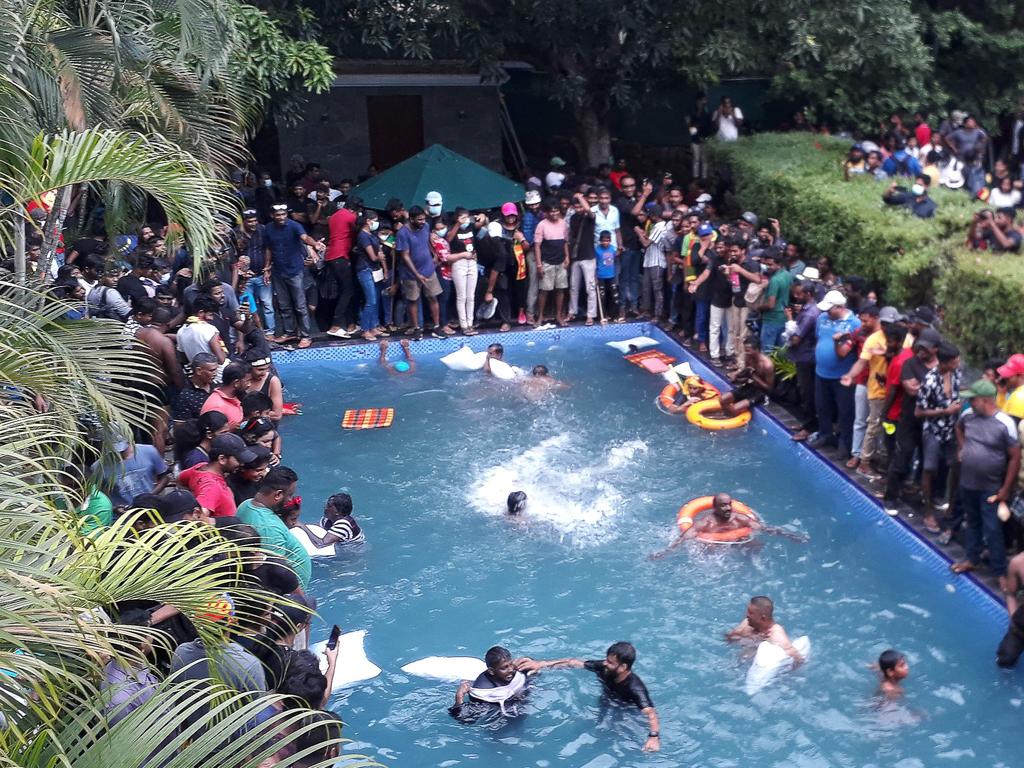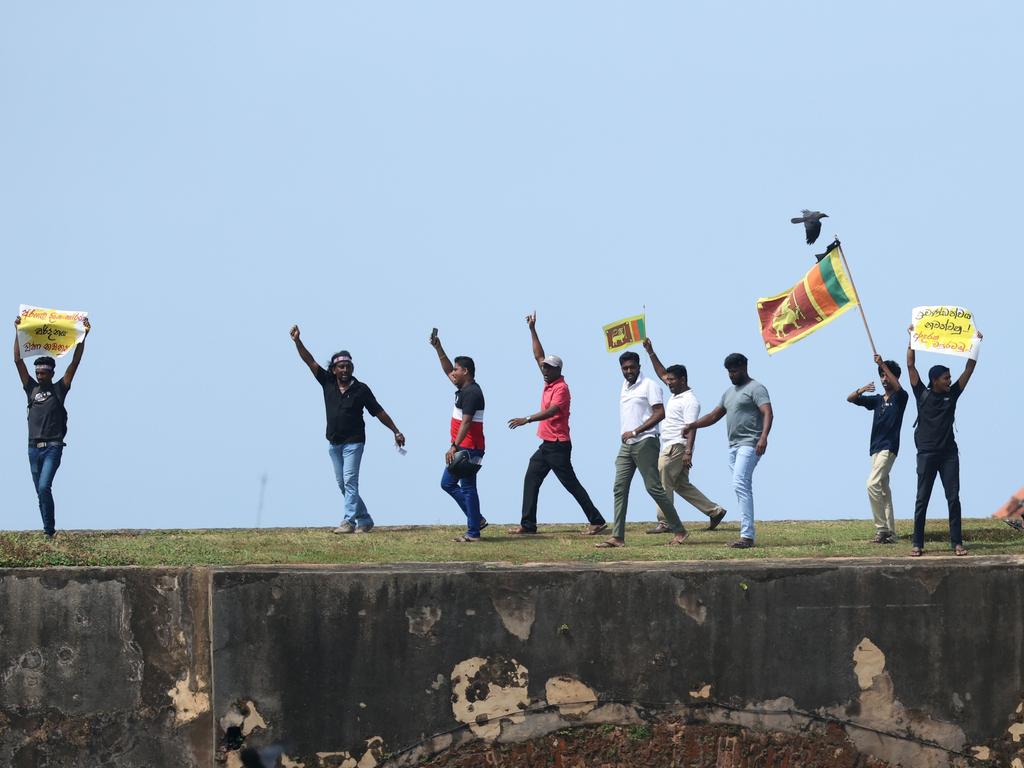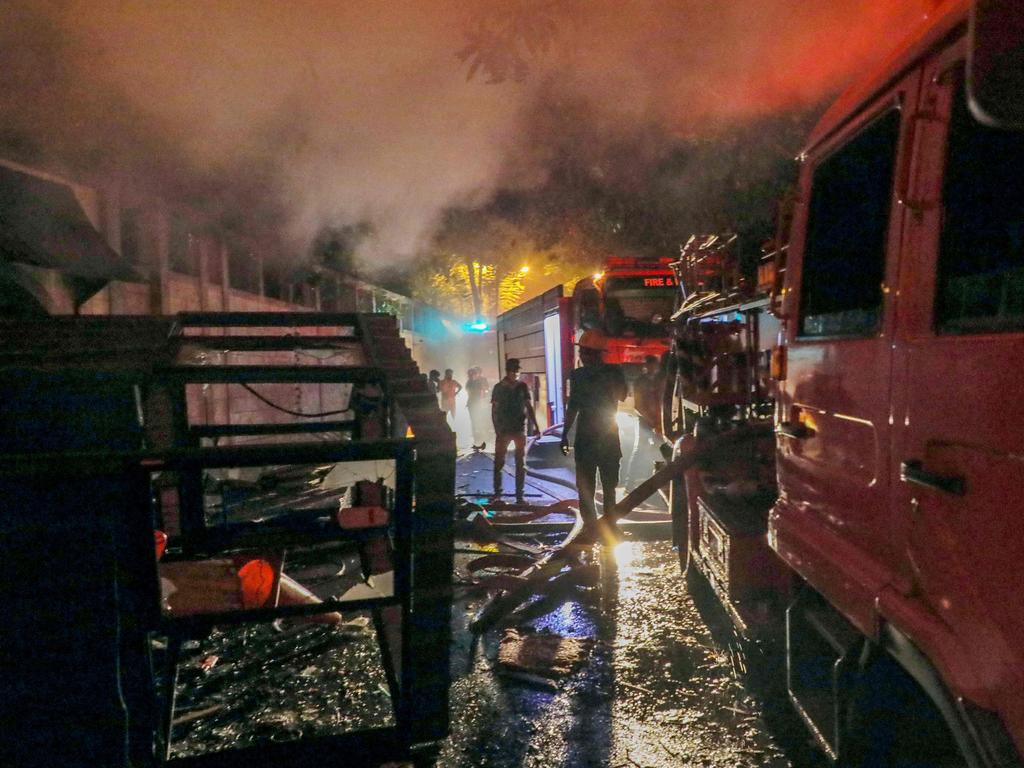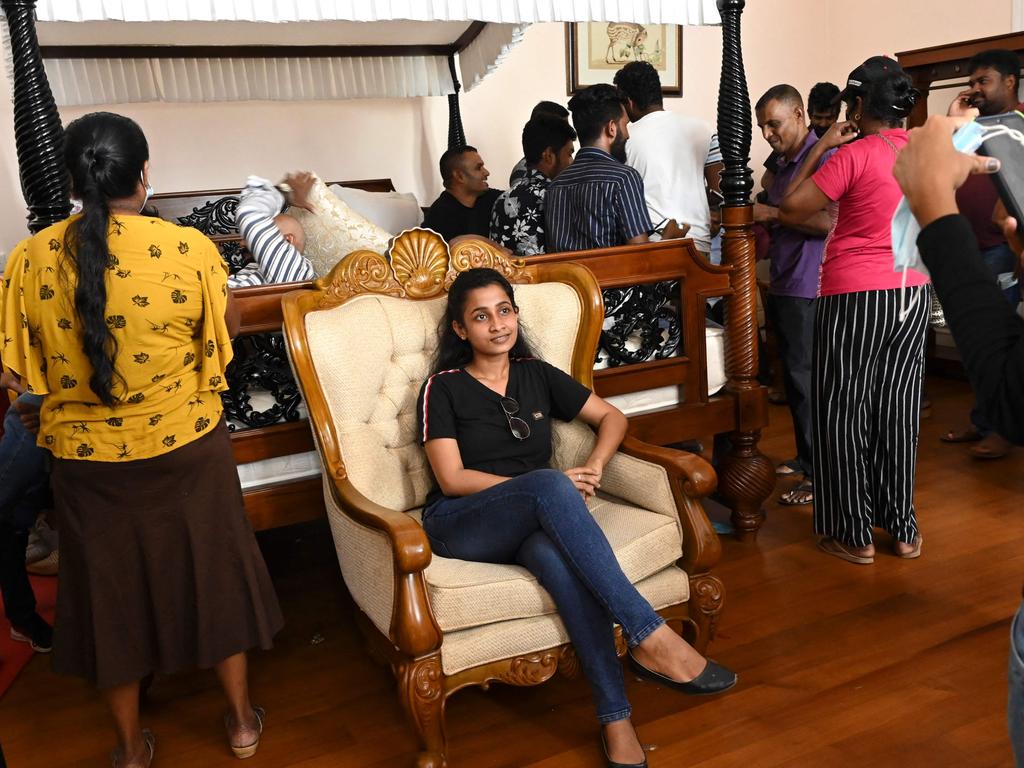Sri Lanka had turned a corner.
In recent years, the island nation in the Indian Ocean that is home to 22 million people was more stable than it had been in decades.
The civil war that left tens of thousands of people dead had, thankfully, ended.
Other problems existed, chief among them being a power imbalance that meant the top 20 per cent of earners enjoyed more than half the country’s wealth.
But people could access food, fuel, medicine, education and healthcare.
Today, Sri Lankans can’t get any of that. They live with acute blackouts and record inflation.
The economy has collapsed under the weight of $75 billion of debt.
Schools are closed and the military has been ordered to stamp out dissent by any means necessary.
The stress of life without the bare necessities came to a head over the weekend when hundreds of thousands of people stormed the Presidential Palace in Colombo and President Gotabaya Rajapaksa fled on a navy vessel.
The path to chaos leads back to a single decision in 2018 that flipped the country on its head.

Protesters demanding the resignation of Sri Lanka’s President Gotabaya Rajapaksa swim in a pool inside the Presidential Palace compound. Picture: AFP
Unprecedented misery
At the time, Gotabaya Rajapaksa’s military career was over and it was time for something new.
The former Sri Lankan army officer put his hand up to run in the 2019 election, despite never holding office.
He ran on a platform of national security that helped secure him the presidency just four years after his brother Mahinda Rajapaksa was defeated. (Mahinda was serving as prime minister until he quit in May amid protests.)
But it was an appointment that would lead Sri Lanka down a dark path.
Almost instantly, Mr Rajapaksa slashed taxes, reducing the amount of income available to buy foreign currency.
He racked up huge debts on what critics say were unnecessary infrastructure projects, while also printing large amounts of money, which pushed up inflation and depleted the country’s foreign reserves.
At the end of 2019, Sri Lanka had $US7.6 billion ($A11.1 billion) in foreign currency reserves, but by March 2020 it had only $US2.3 billion ($A3.4 billion).

Anti-government demonstrators take part in protests on Saturday. Picture: Buddhika Weerasinghe/Getty Images
As the problem grew worse in 2021, the government banned imports of chemical fertiliser in an attempt to stop the outflow of foreign currency.
Farmers were told to use organic fertilisers instead, leading to widespread crop failures.
Sri Lanka now has to import even more food from overseas, further depleting its foreign currency.
All told, Mr Rajapaksa almost single-handedly led Sri Lanka to its most painful downturn since independence from Britain in 1948.
The country defaulted on its debt in April and went cap-in-hand with the International Monetary Fund which has asked Colombo to raise taxes and restructure loss-making state enterprises.
Currently, most offices in Sri Lanka are shut and all schools are closed but hospitals and the main sea and airports in the capital are still operating.
Hundreds of thousands of motorists waited in queues that stretched for kilometres across the country for petrol and diesel.
The situation was never going to end well.

Firefighters try to douse a fire at the residence of the Sri Lanka Prime Minister during protests in Colombo. Picture: AFP
The President is gone. From a naval ship, 73-year-old Mr Rajapaksa, who had clung to power even after deadly nationwide violence in May forced his brother Mahinda Rajapaksa to quit as prime minister, told the speaker of parliament he would step down on Wednesday.
Those who have taken over his residence are refusing to leave.
“Our struggle is not over,” student leader Lahiru Weerasekara told reporters.
“We won’t give up this struggle until he actually leaves.”
Protesters living it up
After what they’ve been through, it seems fitting that protesters should be able to live it up for a short time in the opulence of the Presidential Palace – a world, unlike anything they have known.
After storming the gates of the colonial-era mansion, protesters lounged in its many rooms, somersaulting into the compound’s pool and rummaging through Mr Rajapaksa’s clothes.
At a clock tower near the residence, activists hung an effigy of the President on Sunday evening as thousands of onlookers cheered.
The streets leading to the palace were choked with people, some carrying toddlers and wheeling along the elderly.

People crowd inside the Presidential Palace a day after it was overrun by anti-government protesters. Picture: Arun Sankar/AFP
Troops had fired in the air to help Mr Rajapaksa escape on Saturday. The President then boarded a naval craft which steamed to the safety of the island’s southern waters.
On Sunday, the Presidential Palace was a free-for-all, with children and parents playing on a grand piano, admiring the expensive artwork, picnicking and taking turns to sit in the President’s chair.
“When leaders live in such luxury, they have no idea how the commoners manage,” Buddhist monk Sri Sumida told AFP.
“This shows what can be done when people decide to exercise their power.”
Following the unrest, Colombo National Hospital said 105 people were brought in on Saturday and that 55 remained under treatment on Sunday, including one in a “very critical” state with a gunshot wound.
But the result is undeniable – the protests forced to change. What happens next will matter even more.
More Coverage
Major development as Sri Lanka unravels
It is unclear who, if anyone, will have enough support to take the reins and lead Sri Lanka out of the mud.
The moment it all went wrong for Sri Lanka
Four years ago, a single decision was made that would lead the island nation of Sri Lanka towards collapse. It may never be the same again
Sri Lanka had turned a corner.
In recent years, the island nation in the Indian Ocean that is home to 22 million people was more stable than it had been in decades.
The civil war that left tens of thousands of people dead had, thankfully, ended.
Other problems existed, chief among them being a power imbalance that meant the top 20 per cent of earners enjoyed more than half the country’s wealth.
But people could access food, fuel, medicine, education and healthcare.
Today, Sri Lankans can’t get any of that. They live with acute blackouts and record inflation.
The economy has collapsed under the weight of $75 billion of debt.
Schools are closed and the military has been ordered to stamp out dissent by any means necessary.
The stress of life without the bare necessities came to a head over the weekend when hundreds of thousands of people stormed the Presidential Palace in Colombo and President Gotabaya Rajapaksa fled on a navy vessel.
The path to chaos leads back to a single decision in 2018 that flipped the country on its head.

Protesters demanding the resignation of Sri Lanka’s President Gotabaya Rajapaksa swim in a pool inside the Presidential Palace compound. Picture: AFP
Unprecedented misery
At the time, Gotabaya Rajapaksa’s military career was over and it was time for something new.
The former Sri Lankan army officer put his hand up to run in the 2019 election, despite never holding office.
He ran on a platform of national security that helped secure him the presidency just four years after his brother Mahinda Rajapaksa was defeated. (Mahinda was serving as prime minister until he quit in May amid protests.
But it was an appointment that would lead Sri Lanka down a dark path.
Almost instantly, Mr Rajapaksa slashed taxes, reducing the amount of income available to buy foreign currency.
He racked up huge debts on what critics say were unnecessary infrastructure projects, while also printing large amounts of money, which pushed up inflation and depleted the country’s foreign reserves.
At the end of 2019, Sri Lanka had $US7.6 billion ($A11.1 billion) in foreign currency reserves, but by March 2020 it had only $US2.3 billion ($A3.4 billion).

Anti-government demonstrators take part in protests on Saturday. Picture: Buddhika Weerasinghe/Getty Images
As the problem grew worse in 2021, the government banned imports of chemical fertiliser in an attempt to stop the outflow of foreign currency.
Farmers were told to use organic fertilisers instead, leading to widespread crop failures.
Sri Lanka now has to import even more food from overseas, further depleting its foreign currency.
All told, Mr Rajapaksa almost single-handedly led Sri Lanka to its most painful downturn since independence from Britain in 1948.
The country defaulted on its debt in April and went cap-in-hand with the International Monetary Fund which has asked Colombo to raise taxes and restructure loss-making state enterprises.
Currently, most offices in Sri Lanka are shut and all schools are closed but hospitals and the main sea and airports in the capital are still operating.
Hundreds of thousands of motorists waited in queues that stretched for kilometres across the country for petrol and diesel.
The situation was never going to end well.

Firefighters try to douse a fire at the residence of the Sri Lanka Prime Minister during protests in Colombo. Picture: AFP
The President is gone. From a naval ship, 73-year-old Mr Rajapaksa, who had clung to power even after deadly nationwide violence in May forced his brother Mahinda Rajapaksa to quit as prime minister, told the speaker of parliament he would step down on Wednesday.
Those who have taken over his residence are refusing to leave.
“Our struggle is not over,” student leader Lahiru Weerasekara told reporters.
“We won’t give up this struggle until he actually leaves.”
Protesters living it up
After what they’ve been through, it seems fitting that protesters should be able to live it up for a short time in the opulence of the Presidential Palace – a world, unlike anything they have known.
After storming the gates of the colonial-era mansion, protesters lounged in its many rooms, somersaulting into the compound’s pool and rummaging through Mr Rajapaksa’s clothes.
At a clock tower near the residence, activists hung an effigy of the President on Sunday evening as thousands of onlookers cheered.
The streets leading to the palace were choked with people, some carrying toddlers and wheeling along the elderly.

People crowd inside the Presidential Palace a day after it was overrun by anti-government protesters. Picture: Arun Sankar/AFP
Troops had fired in the air to help Mr Rajapaksa escape on Saturday. The President then boarded a naval craft which steamed to the safety of the island’s southern waters.
On Sunday, the Presidential Palace was a free-for-all, with children and parents playing on a grand piano, admiring the expensive artwork, picnicking and taking turns to sit in the President’s chair.
“When leaders live in such luxury, they have no idea how the commoners manage,” Buddhist monk Sri Sumida told AFP.
“This shows what can be done when people decide to exercise their power.”
Following the unrest, Colombo National Hospital said 105 people were brought in on Saturday and that 55 remained under treatment on Sunday, including one in a “very critical” state with a gunshot wound.
But the result is undeniable – the protests forced to change. What happens next will matter even more.
More Coverage
Major development as Sri Lanka unravels
It is unclear who, if anyone, will have enough support to take the reins and lead Sri Lanka out of the mud.

Leave a Reply
You must be logged in to post a comment.